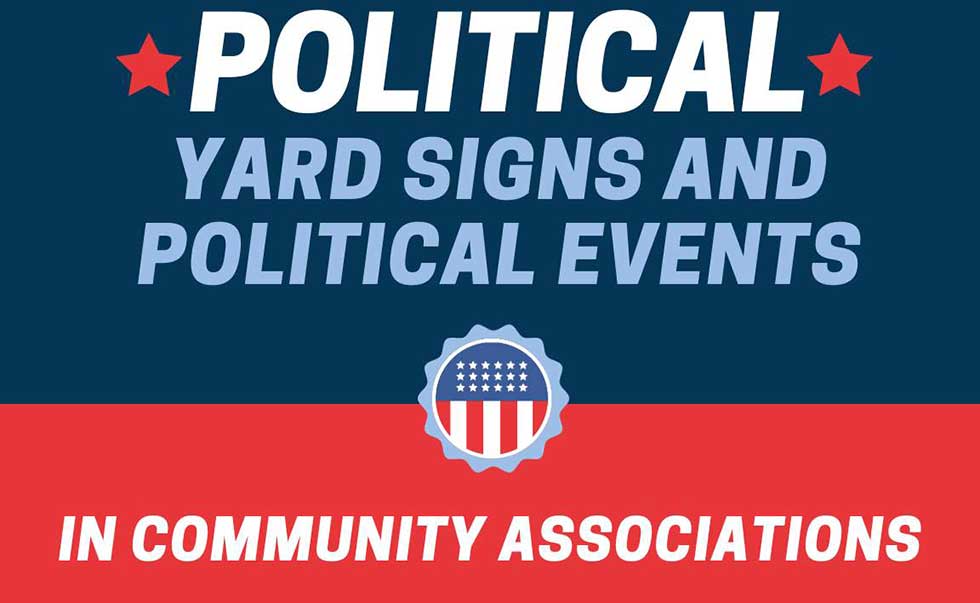PROBHIBITING POLITICAL YARD SIGNS
Unless you share similar political views, your neighbor’s front yard sign supporting a favorite political candidate may be upsetting. Can a Florida community association demand the sign’s removal? A well-crafted and properly adopted board rule prohibiting all signs, as compared to just prohibiting political signs, is likely enforceable with this caveat.
Section 720.304 of the Florida Homeowners’ Association Act provides that any parcel owner may display a sign of reasonable size provided by a contractor for security services within 10 feet of any entrance to the home. In examining an association’s “no-sign” rule, let us first address the argument heard most often, “This is America! The First Amendment protects the right of all homeowners to display political signs in their front yard!”
This is simply not true, and wishing this to be true will not help. In fact, the First Amendment concepts of freedom of speech and freedom of expression certainly apply to governmental settings. But the First Amendment protections generally do not apply where there is no nexus to the federal or state government, and community associations do not have such a nexus.
In 1987 the Florida Supreme Court held, in Quail Creek POA v. Hunter, 538 So. 2d 1288 (Fla. 2d DCA 1989), that neither a homeowners association’s recording of its covenants in the public records, nor the enforcement of its covenants in state court, created a sufficient nexus to evidence “state action” such that the First and Fourteenth Amendment would apply. In 2014 the United States District Court, in Murphree v. The Tides Condominium at Sweetwater, 2014 WL 1293863 (U.S.D.C. MD, Florida, 2014), and citing to Quail Creek POA, held that homeowners’ associations existing under the laws of the State of Florida are not state actors. With that in mind, any homeowner would be hard pressed to argue otherwise.
The 1987 case of Brock v. The Watergate Mobile Home Park Association, Inc., 502 So.2d 1380 (4th DCA 1987) provides the necessary guidance to determine whether there is a sufficient nexus to the government such that the First Amendment would apply. There are two primary tests: the public function test and the state involvement test.
Under the public function test, state action will be found where the functions of a private individual or group are so impregnated with a governmental character as to appear municipal in nature… under the state involvement test, there must be a sufficiently close nexus between the state and the challenged activity such that the activity may be fairly treated as that of the state itself.
Should an association adopt a rule prohibiting one type of sign but allowing other types of signs, then notwithstanding the arguments that the First Amendment does not apply to community associations, this could create an argument that the association is regulating the type and manner of speech, and thus, might inadvertently be leaving room for a First Amendment-type argument to be used against the association.
Courts have long since held that owners give up certain liberties when living in a community association. In 2002 the Florida Supreme Court held in Woodside Village v. Jahren, 806 So. 2d 452 (Fla. 2002), that certain individual rights must be compromised when one chooses to live in an association. With that as our backdrop, any “no-sign” rule should be artfully drafted to help ensure enforceability. There is no margin for error. The dispositive court cases regarding rule enforceability make clear that a sign restriction must be “clear and unambiguous” to be enforceable against an owner. Remember, a basic principle of contract interpretation is that ambiguous terms are held against the drafting party. As a practical matter, in plain English this means that in the event the rule is even slightly confusing, the homeowner will receive the benefit of the doubt. Also, any covenant or rule must be applied fairly to avoid selective enforcement rebuttals; so, if Dorothy the Democrat is told to remove her lawn sign, so, too, must Roger the Republican be similarly told. Remember, too, that as a general rule, courts favor covenants adopted by the membership over rules adopted by the board; meaning, the former serves to increase the association’s chances of prevailing in the event of an owner’s legal challenge.
That rules prohibiting signs must be artfully drafted was a point made very clear to the homeowners’ association in Shields v. Andros Isle Property Owners Association, Inc., 872 So. 2d 1003 (Fla. 4th DCA 2004), in which the Fourth District Court of Appeal of Florida decided in favor of the homeowner who displayed a sign in her car window despite the association’s sign prohibition. The association’s rules prohibited the display of signs “on any lot,” except a “for sale” sign of a certain size, and prohibited signs on a vehicle. The Court, using the definition of a “lot” in the association’s declaration, interpreted these rules to mean that no sign, except a “for sale” sign, may be on the land or on the exterior of a vehicle. However, there was no prohibition for signs displayed from within a vehicle. When ambiguity exists, courts will rule in favor of the non-drafting party. In this instance the association is deemed the drafter of the rule, so therefore the ambiguity was held against the association, which worked to the owner’s benefit.
Consider, too, election season is short. By the time a lawsuit for an injunction to enforce the “no-sign” covenant is fully resolved, it might be time to consider the next presidential candidate! Also, it is important to take into account the holdings and principles that result from Alorda v. Sutton Place Homeowners Association, Inc., 82 So. 3d 1077 (Fla. 2d DCA 2012) and Mauriello v. The Property Owners Association of Lake Parker Estates, Inc., Case No. 2D21-500 (Fla. 2d DCA 2022) where it becomes quite clear that, if the association has a permissive right to self-help, that such self-help must be exercised, or at least attempted to be exercised, prior to seeking an injunction from the court. This is because all legal remedies must be exhausted before seeking an equitable remedy. Recall that the declaration of covenants is a legally binding contract. The fact that it includes language such as, “the association may, but is not obligated to enter an owner’s lot to cure a violation” is interpreted by the courts to mean that the association must exercise its self-help option before seeking an injunction. Please be sure to consult with your association’s attorney when considering enforcing rules and regulations.
Prohibiting Use of Common Areas and Clubhouse for Political Events
Can a Florida community association adopt rules prohibiting the use of the common areas and clubhouse for political events? Generally speaking, the board can adopt such a rule; but there are statutory exceptions which provide for the right of the members to peaceably assemble, and which allow for the invitation of public officers and candidates for public office to speak in common areas. More specifically, Section 720.304(1), Florida Statutes (i.e., the Florida Homeowners’ Association Act), provides the following:
All common areas and recreational facilities serving any homeowners’ association shall be available to parcel owners in the homeowners’ association served thereby and their invited guests for the use intended for such common areas and recreational facilities. The entity or entities responsible for the operation of the common areas and recreational facilities may adopt reasonable rules and regulations pertaining to the use of such common areas and recreational facilities. No entity or entities shall unreasonably restrict any parcel owner’s right to peaceably assemble or right to invite public officers or candidates for public office to appear and speak in common areas and recreational facilities.
(Note that similar provisions exist in both the Condominium and Cooperative Acts in §718.123 and §719.109, Fla. Stat., respectively.)
With these statutory rights in mind, should an association member invite a candidate for political office to speak, the association must allow use of the clubhouse or other common area for the candidate to address the members. If members peaceably assemble and discuss today’s political events, that, too, seems to be a statutory protected right. However, if a political group requests use of the clubhouse to host an event in support of a candidate or political party, then it likely could be prohibited except that the candidate would still be permitted to speak, and every association member would be allowed to attend, even those who may desire to protest.
If a rule adopted by the association prohibits the use of the clubhouse for political events and if legally challenged by an upset member, while it is difficult to predict the outcome, the court will need to balance the reasonableness of the board’s adopted rule as compared against the statutory protection. It should also be kept in mind that if your association was created prior to the legislation protecting a political candidate’s right to speak, and the declaration does not contain a provision adopting the legislation through “Kaufman”-type language (meaning it’s as if the legislation was adopted into the declaration), then such an association has an argument that such substantive legislation does not apply. (These rights came into existence on the following dates: October 1, 1977, for condominiums and cooperatives and April 1, 1992, for homeowners’ associations.) When crafting such rules, consultation with the association’s legal counsel is strongly recommended.



